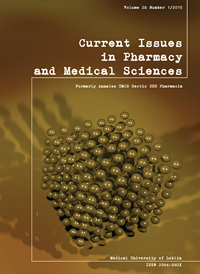Changes of nitric oxide system and lipid peroxidation parameters in the digestive system of rats under conditions of acute stress, and use of nonsteroidal anti-inflammatory drugs
DOI:
https://doi.org/10.1515/cipms-2015-0040Keywords:
stress, nitric oxide, lipid peroxidation, gastrointestinal tract, NSAIDsAbstract
The use of nonsteroidal anti-inflammatory drugs (NSAIDs) in combination with being physiologically stressed often occurs in in the course of different pathologies. This situation may result in the alteration of digestive system functioning. The effect of stress brings about changes in the activity of nitric oxide synthase (NOS), arginase, cyclooxygenase (COX) and lipid peroxidation, whereas the use of NSAIDs interrupts the multiple functions of the cell via the inhibition of prostaglandins (PGs) synthesis. Taking into account that NOS and COX-systems are connected in their regulation, the aim of the study was to determine the role played by NOS and lipid peroxidation under conditions of the combined action of NSAIDs and stress. In our study, male rats were used. The NSAIDs (naproxen - a non-selective COX inhibitor, celecoxib - a selective COX-2 blocker, and the compound 2A5DHT (which is the active substance of dual COX, and the lipoxygenase (LOX) inhibitor, darbufelone) were all administered at a dose 10 mg/kg, prior to water restraint stress (WRS). WRS brought about an increase of inducible NOS (iNOS) activity in the intestinal mucosal and muscular membranes, as well as in the pancreas. Because of this, constitutive NOS izoform (cNOS) and arginase activities decreased. Moreover, the MDA concentration increased, indicating the development of oxidative stress. In our work, pretreatment with naproxen, as in the WRS model, engendered a decrease in iNOS activity. What is more, administration of Celecoxib did not change iNOS activity, as compared to WRS alone, and it showed a tendency to reduce lipid peroxidation. In addition, 2A5DHT prior WRS brought about a decrease of iNOS activity, with the subsequent rise of cNOS activity. Of note, MDA concentration decreased in all studied organs, indicating the reduction of lipid peroxidation under the action of the darbufelone active substance.
References
1. Brzozowski T. et al.: Physiological mediators in nonsteroidal antiinflammatory drugs (NSAIDs)-induced impairment of gastric mucosal defense and adaptation. Focus on nitric oxide and lipoxins. J Physiol Pharmacol., 59, 2, 2008.
2. Filaretova L.: Gastroprotective role of glucocorticoids during NSAID-induced gastropathy. Curr Pharm Des., 19, 29, 2013.
3. Fomenko I.S. et al.: Parameters of NO synthase system of gastric mucosa in rats under stress conditions and inhibition of cyclooxygenase. Fiziol Zh., 60, 2, 2014.
4. Fomenko I. et al.: Effects of conventional and hydrogen sulfidereleasing non-steroidal anti-inflammatory drugs in rats with stressinduced and epinephrine-induced gastric damage. Stress, 17(6), 528, 2014. [CrossRef] [Web of Science]
5. Geyer J.W., Dabich D.: Rapid method for determination of arginase activity in tissue homogenates. Anal Biochem., 39(2), 412, 1971. [CrossRef]
6. Jaworek J. et al.: Involvement of cyclooxygenase-derived prostaglandin E2 and nitric oxide in the protection of rat pancreas afforded by low dose of lipopolysaccharide. J Physiol Pharmacol., 52, 1, 2001.
7. Konturek P.C. et al.: Gastric ulcer healing and stress-lesion preventive properties of pioglitazone are attenuated in diabetic rats. J Physiol Pharmacol., 61, 4, 2010.
8. Kudryavtsev K.V. et al.: Pharmacological correction of stressinduced gastric ulceration by novel small-molecule agents with antioxidant profile. Scientific World Journal, Article ID 217039, 2014. [Web of Science]
9. Lunberg J.О., Weitzberg E.: Biology of nitrogen oxides in the gastrointestinal tract. Gut, 62(4), 616, 2013.[CrossRef] [Web of Science]
10. Martel-Pelletier J., Lajeunesse D., Reboul P.: Therapeutic role of dual inhibitors of 5-LOX and COX, selective and non-selective nonsteroidal anti-inflammatory drugs. Ann Rheum Dis, 62(6), 501, 2003. [CrossRef]
11. Mollace V et al. Modulation of prostaglandin biosynthesis by nitric oxide and nitric oxide donors. Pharmacol Rev., 57(2),217, 2005. [CrossRef]
12. Musumba C., Pritchard D.M., Pirmohamed M.: Review article: cellular and molecular mechanisms of NSAID-induced peptic ulcers. Aliment Pharmacol Ther, 30(6), 517, 2009. [CrossRef] [Web of Science]
13. Sklyarov A.Y., Panasyuk N.B., Fomenko I.S.: Role of nitric oxidesynthase and cyclooxygenase/lipooxygenase systems in development of experimental ulcerative colitis. J Physiol Pharmacol., 62, 65, 2011.
14. Takeuchi K.: Pathogenesis of NSAID-induced gastric damage: importance of cyclooxygenase inhibition and gastric hypermotility. World J Gastroenterol. 18, 18, 2012. [CrossRef] [Web of Science]
15. Turkevych N.M.: Vvedenskij V.M., Petlichnaya L.P. Ukr. Khim. Zh. (Russ. Ed.), 1961.
Downloads
Published
Issue
Section
License
Copyright (c) 2015 Authors

This work is licensed under a Creative Commons Attribution-NonCommercial-NoDerivatives 3.0 Unported License.


